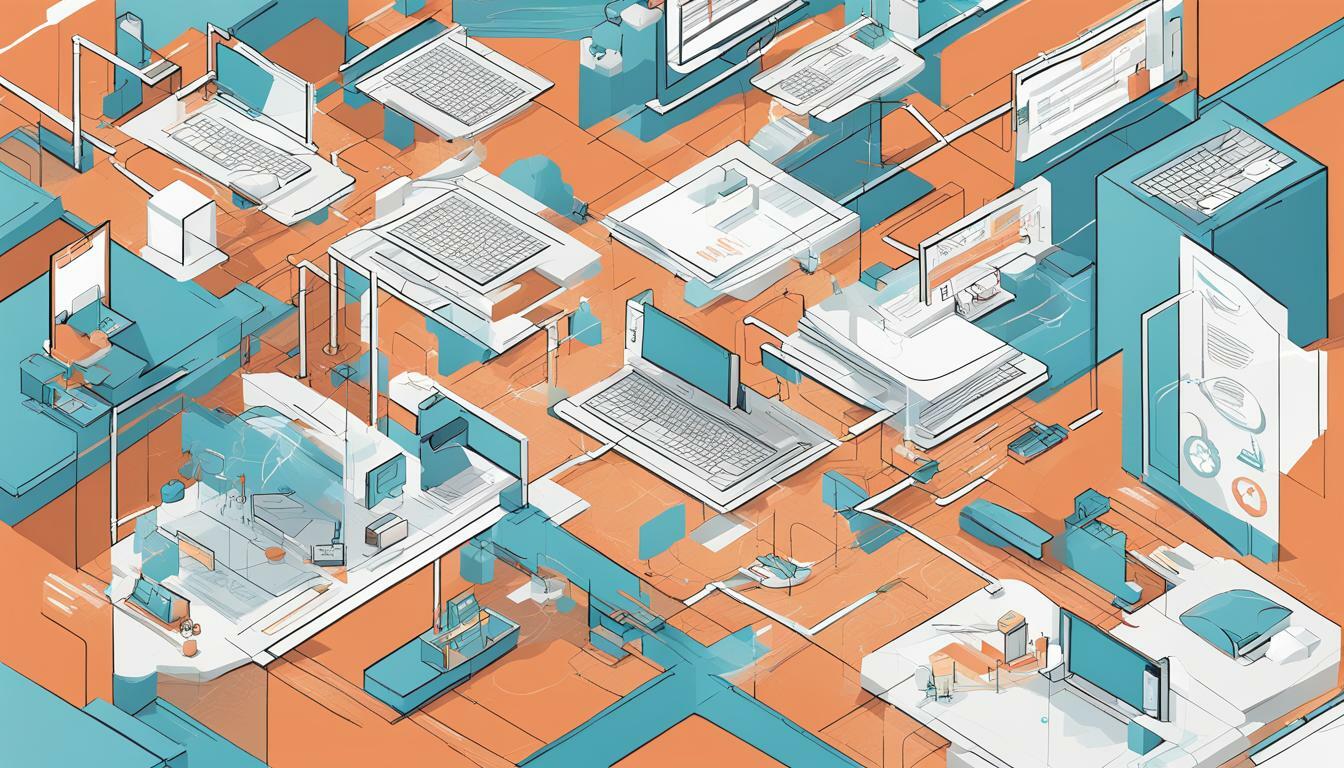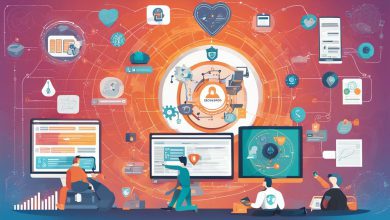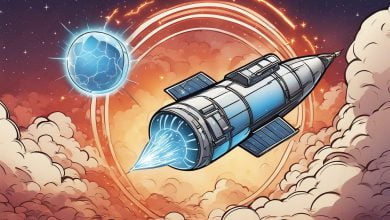
Event-Driven Architecture has quickly become a popular approach to software development in recent years. It allows for a highly scalable and responsive system by leveraging asynchronous and decoupled communication between components. In this comprehensive guide, we will explore the fundamentals of Event-Driven Architecture, its core principles, and its benefits. We will also delve deeper into event-driven systems, event-driven programming and design, building event-driven applications, and event-driven microservices. Additionally, we will discuss best practices for implementing and evolving Event-Driven Architecture and strategies for scaling and maintaining resilient systems.
Key Takeaways:
- The Event-Driven Architecture approach allows for a highly scalable and responsive system by leveraging asynchronous and decoupled communication between components.
- Event-Driven Architecture differs from traditional approaches and has many benefits, including scalability, responsiveness and modularity.
- Event-Driven Architecture consists of event-driven systems, event-driven programming and design, and building event-driven applications and microservices.
- Designing resilient and fault-tolerant event-driven systems is crucial to maintain system stability.
- Implementing best practices for Event-Driven Architecture can ensure success and avoid common pitfalls.
- Scaling and evolving Event-Driven Architecture requires strategies like horizontal scaling and partitioning events.
What is Event-Driven Architecture?
Event-Driven Architecture (EDA) is a software development approach that prioritizes the use of events to facilitate communication and data flow between different components of a system. Unlike traditional architectures that rely on synchronous communication, EDA is entirely asynchronous, which enables greater scalability, responsiveness, and flexibility.
At its core, EDA is based on a simple idea: instead of directly invoking functions or calling APIs, a system reacts to events that occur within it. Events can be anything from user actions, system notifications, or data changes, and they act as triggers for specific actions or processes within the system.
EDA has several essential components, including event producers, event consumers, and event buses. Event producers are components that generate events and publish them to the event bus, while event consumers subscribe to specific events and react to them as necessary. Event buses act as a central hub for events, allowing different components to communicate with each other seamlessly.
Benefits of Event-Driven Architecture
One of the most significant advantages of EDA is its ability to scale effectively. By decoupling application components and making them event-driven, it becomes much easier to scale up or down as necessary, without affecting the rest of the system. This makes EDA ideal for building large, complex applications that need to handle a high volume of traffic and data.
EDA also offers greater modularity, making it easier to develop and maintain large systems. Because individual components are loosely coupled and entirely independent, it’s much simpler to add, remove, or change components without affecting the overall system. This results in greater flexibility and adaptability, which is essential for modern software development.
Finally, EDA enables greater responsiveness, as events can be processed in real-time, allowing applications to react quickly to changing conditions or user actions. This is particularly important for applications that need to provide real-time data or analytics, such as financial or trading systems.
Understanding Event-Driven Systems
Event-driven systems are based on the concept of events, which are messages that represent a change of state or a notable occurrence within a software system. These events can be generated by users, applications, or devices, and are used as the basis for communication and data flow within the system.
The key components of an event-driven system are event producers, event consumers, and event buses. Event producers generate events and publish them to the event bus, which acts as a messaging layer that handles the distribution of events to interested consumers. Event consumers subscribe to events on the event bus and are notified whenever an event of interest is published.
One of the main advantages of event-driven systems is their ability to decouple components, allowing for greater flexibility and scalability. By using events as a means of communication, components are able to interact without being tightly coupled to one another, which makes it easier to modify or replace individual components. Additionally, event-driven systems are highly responsive to changing conditions, as they are able to dynamically adjust to changes in the system or its environment.
Other benefits of event-driven systems include improved fault tolerance and ease of debugging. Because events are discrete and represent well-defined actions, it is easier to pinpoint the source of errors within a system and to automatically recover from failures. Event-driven systems are also well-suited to handling complex, multi-step processes, as events can be used to trigger and coordinate a series of actions across multiple components.
Event-Driven Programming and Design
Event-driven programming is a paradigm where the flow of execution is determined by events or messages. In this approach, events act as triggers for actions, and the system is designed to respond to those events in an asynchronous and non-blocking way.
Event-driven design is a process of building systems that rely on events as the primary means of communication. It involves identifying the events that are relevant to the system’s domain, defining their structure and behavior, and designing the components that will produce and consume those events.
One of the key advantages of event-driven programming and design is their ability to build systems that are scalable, flexible, and modular. By decoupling components and relying on asynchronous communication, event-driven systems can handle high volumes of traffic and adapt to changing requirements without sacrificing performance or reliability.
Event-driven systems also facilitate event sourcing, which is a technique of capturing all changes to an application state as a sequence of events. This approach enables a system to have a complete history of its changes, which can be used for auditing, debugging, and data analysis.
CQRS (Command Query Responsibility Segregation) is another pattern that is often used in event-driven systems. CQRS separates read and write operations into different components, allowing them to scale independently and optimizing each for its specific task.
In summary, event-driven programming and design are powerful tools for building modern software systems that can handle high volumes of traffic, adapt to changing requirements, and provide a complete history of their changes. By leveraging the principles of asynchronous communication, modularity, and event sourcing, developers can create systems that are both flexible and scalable.
Building Event-Driven Applications
Building event-driven applications requires a different approach to software development compared to traditional architectures. A key aspect of event-driven development is placing events at the center of the system design, rather than functions or objects.
The first step in building event-driven applications is to define the events that will be used to trigger actions within the system. This process is called event modeling and involves identifying the events that are most relevant to the business domain being addressed.
Event-driven development methodologies like Domain-Driven Design (DDD) and Behavior-Driven Development (BDD) can be used to support this process, helping to ensure that the events used in the system reflect the core concerns of the business.
Once the events have been identified, the next step is to design the event handlers that will respond to those events. Event handlers are functions or services that are triggered by specific events and are responsible for executing the necessary actions in response.
Event-driven development requires a different mindset to traditional request/response programming. It is essential to consider scenarios where events may arrive out of order or duplicate events may be received. Techniques such as idempotency and event replay can be used to ensure that systems remain consistent under these circumstances.
The tools and frameworks used in event-driven development are different from those used in traditional architectures. Event-driven frameworks like Apache Kafka and RabbitMQ can be used to implement event-driven messaging, while cloud-based services like AWS Lambda and Azure Functions can be used for serverless event-driven processing.
The Event-Driven Model
At the heart of Event-Driven Architecture is the event-driven model, a paradigm that facilitates communication and coordination between different components in a system. This model defines how events are created, consumed, and propagated within an architecture, providing a standard for decoupling different parts of a system.
In an event-driven model, events are first defined as a type of message that carries relevant data about a specific occurrence. These events are then published by an event producer, which can be any component that generates events – from user interactions to system processes. Once published, events are picked up by event consumers, which can be any component that can respond to specific events.
To ensure efficient event routing, event-driven architectures typically rely on event buses – a central system that manages the distribution of events between different components. These buses ensure that events are delivered to their intended consumers and handle any communication protocols that might be required.
The event-driven model also plays a critical role in ensuring data consistency within an architecture. Since events reflect real-world occurrences, they provide a natural way to capture and track changes to a system’s data. Thus, event-driven systems often store their data in an event stream, which captures all the events that have occurred in the system in chronological order. This approach ensures that all components have access to the most up-to-date data, and can use it to make informed decisions.
Overall, the event-driven model plays a critical role in building scalable, responsive, and flexible systems that can adapt to changing requirements over time. By providing a standard for communication and coordination, it ensures that different components can work together seamlessly, without being tightly coupled.
Asynchronous Architecture in Event-Driven Systems
Asynchronous communication is a fundamental aspect of event-driven systems, enabling components to exchange information without blocking or waiting for synchronous responses. This approach allows for greater scalability and responsiveness, as components can process events independently and in parallel. However, asynchronous architecture also poses some challenges, such as ensuring message ordering and consistency, handling timeouts and retries, and dealing with failures and errors.
One common pattern in event-driven messaging is the use of queues to store and forward events between producers and consumers. Queues can act as buffers, decoupling components and providing a level of fault tolerance and load balancing. However, managing queues requires careful design and configuration, as well as monitoring and alerting mechanisms to detect and address performance or availability issues.
Another pattern is the use of event-driven message brokers, such as Apache Kafka or RabbitMQ, which provide a distributed and scalable way to manage event streams. These brokers can handle large volumes of events and ensure fault tolerance and durability, allowing components to process events asynchronously and reliably. However, understanding the nuances of message brokers and their configuration can be complex, requiring careful consideration of topics like partitioning, replication, and retention policies.
Event-Driven Messaging
A key aspect of asynchronous architecture is event-driven messaging, which enables producers and consumers to communicate through events that are published and subscribed to without direct coupling. This allows for loose coupling of components, enabling independent and flexible development and deployment. However, it also requires careful consideration of event schemas and contracts, versioning and evolution, and validation and serialization.
One challenge with event-driven messaging is ensuring message ordering and consistency, especially in distributed environments. Techniques like event versioning, sequence numbers, and timestamps can help maintain order and prevent race conditions or conflicts. Additionally, techniques like event replay and idempotency can help recover from failures or duplicates, ensuring data integrity and consistency.
Overall, event-driven architectures can benefit from asynchronous communication, but require careful planning and design to ensure reliable and efficient messaging. By leveraging event-driven messaging patterns and tools, developers can build resilient and scalable event-driven systems.
Event-Driven Microservices
Event-driven architecture and microservices make a powerful combination for building highly scalable and responsive systems. Event-driven microservices are designed to handle specific business functions and communicate with each other asynchronously.
One of the key benefits of event-driven microservices is their ability to handle high volumes of events and scale horizontally in response to increased load. By decoupling services and implementing event-driven communication, developers can build systems that are agile and flexible, even as requirements evolve over time.
When designing event-driven microservices, it’s important to consider factors like event routing, event schemas, and service orchestration. Event-driven messaging patterns like publish/subscribe, request/response, and event sourcing can also be used to ensure that services can communicate effectively and maintain consistency in their data.
As with any microservice-based architecture, event-driven microservices require careful planning and design to ensure that services can be deployed independently and scaled effectively. Developers must also consider issues like service discovery, logging, and monitoring to ensure that the system can be managed effectively.
Ultimately, event-driven microservices represent an exciting new frontier in software architecture, offering a powerful approach to building scalable and resilient systems that can adapt to changing business needs. With the right design principles and tooling in place, event-driven microservices can help organizations build software that delivers measurable business value.
Designing Resilient Event-Driven Systems
Designing resilient event-driven systems is crucial for ensuring that applications can handle unexpected errors and failures. In event-driven systems, components are loosely coupled, and messages are passed asynchronously. This means that errors can occur at any stage, and they must be handled gracefully to prevent system-wide failures.
One technique for designing resilient systems is event replay. In this approach, events are saved and replayed in the event of a failure, ensuring that no data is lost. However, it’s essential to ensure that replayed events don’t cause duplicate processing or updates, which can lead to data inconsistencies.
Another important concept is idempotency, which ensures that processing the same event multiple times has the same result as processing it once. This is important for preventing accidental duplicate updates and ensuring consistent data across the system.
When it comes to distributed transactions, it’s crucial to ensure that all events and operations within the transaction are processed and committed successfully before any changes are made to the system. This helps prevent partial updates and data inconsistencies.
Error handling is also a critical aspect of designing resilient systems. It’s important to have a clear understanding of all possible error scenarios and to have robust error handling and recovery mechanisms in place. For example, retrying failed operations, logging errors for analysis, and rolling back transactions when necessary can help ensure system stability.
| Techniques for Designing Resilient Event-Driven Systems: |
|---|
| Event replay |
| Idempotency |
| Distributed transactions |
| Error handling |
Finally, monitoring is a critical component of any resilient system. Event-driven systems generate a large volume of events, and it’s crucial to have tools and processes in place to monitor the system’s health and performance continually. For example, monitoring metrics like event consumption rates, message queue depths, and error rates can help identify potential issues before they lead to system-wide failures.
Designing resilient event-driven systems requires careful planning, robust error handling, and continuous monitoring. By implementing event replay, idempotency, and distributed transactions, and having reliable error handling and recovery mechanisms in place, you can ensure that your event-driven systems are scalable, performant, and reliable.
Implementing Event-Driven Architecture: Best Practices
Implementing Event-Driven Architecture (EDA) can be challenging, but following best practices can help ensure success. Below we’ve outlined some key steps to take when implementing EDA:
- Define clear, concise event schemas: Ensure that the structure and meaning of events are well-defined and easily understood. Utilize versioning to ensure compatibility and support evolution over time.
- Use event-driven development methodologies: Adopt agile development principles and continuous delivery to allow for frequent releases and fast iteration.
- Consider event security: Ensure that events are secured and authenticated to prevent unauthorized access or tampering.
- Plan for event schema evolution: Ensure that the system can gracefully handle changes in event schemas over time without breaking existing consumers.
- Implement proper error handling: Adopt comprehensive error handling and retry mechanisms to ensure the resilience and availability of the system.
- Monitor the system: Implement effective monitoring and alerting mechanisms to identify and respond to issues quickly.
It’s also important to understand and avoid common pitfalls when implementing EDA. These include:
- Overcomplicating event schemas or failing to properly version them
- Not considering security and authentication when designing the system
- Not properly handling errors and retries
- Forgetting to monitor and alert the system for issues
By following best practices and avoiding common pitfalls, organizations can successfully implement EDA and reap the benefits of a modern, scalable, and resilient system.
Scaling and Evolving Event-Driven Architecture
Scaling event-driven architectures can be a challenging but essential task to ensure that your system can handle increased traffic and maintain its responsiveness. One way to scale an event-driven architecture is through horizontal scaling, where you add more instances of your microservices to handle the increased load. Distributed event-driven architectures are inherently scalable as they can handle multiple events from various sources without losing performance.
An essential part of scaling an event-driven architecture is partitioning the events to ensure that they are processed efficiently and effectively. By partitioning your events, you can distribute the load across multiple nodes, and each node will only need to handle a subset of events. This approach can help to reduce the risk of bottlenecks and increase the overall throughput of your system.
Another strategy to scale event-driven architectures is to use event-driven integration patterns such as publish-subscribe or point-to-point communication. Publish-subscribe patterns can help to distribute events to multiple subscribers, whereas point-to-point communication can be used to send events to a specific subscriber. This approach can help to reduce the risk of overloading your system and ensure that events are processed in a timely and efficient manner.
Evolution is an integral part of any software system, and event-driven architectures are no exception. One way to evolve your event-driven architecture is by introducing new event types or changing existing ones. A good practice is to version your events to ensure that consumers can handle new event schemas gracefully.
It is also important to monitor the events to ensure that they are processed correctly and that there are no errors or delays. You can use tools like event-driven monitoring to track the flow of events through your system and identify potential issues or bottlenecks.
Scaling and evolving event-driven architectures can be a challenging task, but with careful planning, design, and implementation, you can create a scalable and responsive system that can handle any event effectively.
Conclusion
Event-Driven Architecture is a powerful and flexible approach to building software systems that can help organizations achieve greater scalability, responsiveness, and modularity. By leveraging events as triggers for action, event-driven systems can efficiently handle complex business processes and adapt to changing conditions in real-time.
Throughout this comprehensive guide, we have explored the key principles and design patterns behind Event-Driven Architecture and provided practical guidance for building resilient and scalable systems. We have covered topics like event-driven programming and design, building event-driven applications, and implementing asynchronous architecture in event-driven systems.
We have also discussed the role of event-driven microservices and explored strategies for scaling and evolving event-driven architectures over time. By following best practices like event schema evolution, versioning, and security considerations, organizations can ensure that their event-driven systems are optimized for performance and maintainability.
In conclusion, Event-Driven Architecture represents a paradigm shift in the way we design and build software systems. By embracing this approach, organizations can gain a competitive edge, delivering more value to their customers and stakeholders. We hope this guide has been a valuable resource for understanding Event-Driven Architecture and its applications in modern software development.
FAQ
Q: What is Event-Driven Architecture?
A: Event-Driven Architecture is an architectural style that emphasizes the communication and coordination of software components through the use of events. It allows for asynchronous, loosely coupled systems that can easily scale and adapt to changing requirements.
Q: How does Event-Driven Architecture differ from traditional approaches?
A: Unlike traditional approaches where components are tightly coupled and communicate through direct method calls, Event-Driven Architecture enables decoupling by introducing events as a means of communication. Components can publish and subscribe to events, allowing for more flexibility and scalability.
Q: What are the benefits of Event-Driven Architecture?
A: Event-Driven Architecture offers several benefits, including increased scalability, responsiveness, and modularity. It allows systems to handle a large number of events concurrently, respond quickly to new events, and easily add or remove components without impacting the overall system.
Q: What are event-driven systems?
A: Event-driven systems are software architectures that rely on events as the primary means of communication and coordination. They consist of event producers, which generate events, event consumers, which react to events, and event buses, which facilitate the flow of events between components.
Q: How do event-driven programming and design fit into Event-Driven Architecture?
A: Event-driven programming and design are the principles and practices used to implement Event-Driven Architecture. They involve designing software components that can react to events and implementing event handlers to respond to specific events. This approach enables reactive and scalable systems.
Q: How can I build event-driven applications?
A: Building event-driven applications involves several steps, including event modeling, selecting appropriate development methodologies, and utilizing tools and frameworks that support Event-Driven Architecture. It’s important to understand the flow of events and design components that can handle them effectively.
Q: What is the event-driven model?
A: The event-driven model is a conceptual framework for organizing and managing events within an architecture. It involves defining event schemas, publishing events to event buses, and consuming those events within components. The event-driven model ensures the proper flow of events and enables loose coupling between components.
Q: How does asynchronous architecture factor into event-driven systems?
A: Asynchronous architecture plays a vital role in event-driven systems. It allows components to communicate without blocking each other, leading to better scalability and responsiveness. Asynchronous communication patterns like event-driven messaging and queue-based processing facilitate the decoupling and distributed nature of event-driven systems.
Q: What are event-driven microservices?
A: Event-driven microservices are small, independent services that communicate through events. They leverage the benefits of Event-Driven Architecture, such as scalability and fault tolerance, within a microservices architecture. Event-driven microservices can be orchestrated or choreographed to achieve complex workflows and business processes.
Q: How can I design resilient event-driven systems?
A: Designing resilient event-driven systems involves implementing techniques like event replay, idempotency, and distributed transactions. These techniques ensure that events can be replayed in case of failures, guarantee the consistency of data across components, and handle errors gracefully. Monitoring and error handling are also crucial aspects of resilience.
Q: What are some best practices for implementing Event-Driven Architecture?
A: When implementing Event-Driven Architecture, it’s important to consider factors like event schema evolution, event versioning, and event-driven security considerations. Additionally, understanding common pitfalls and avoiding them can greatly improve the success of event-driven projects.
Q: How can I scale and evolve Event-Driven Architecture?
A: Scaling and evolving Event-Driven Architecture involves strategies like horizontal scaling, partitioning events, and utilizing event-driven integration patterns. These approaches ensure that systems can handle increased event loads and adapt to changing requirements over time.








